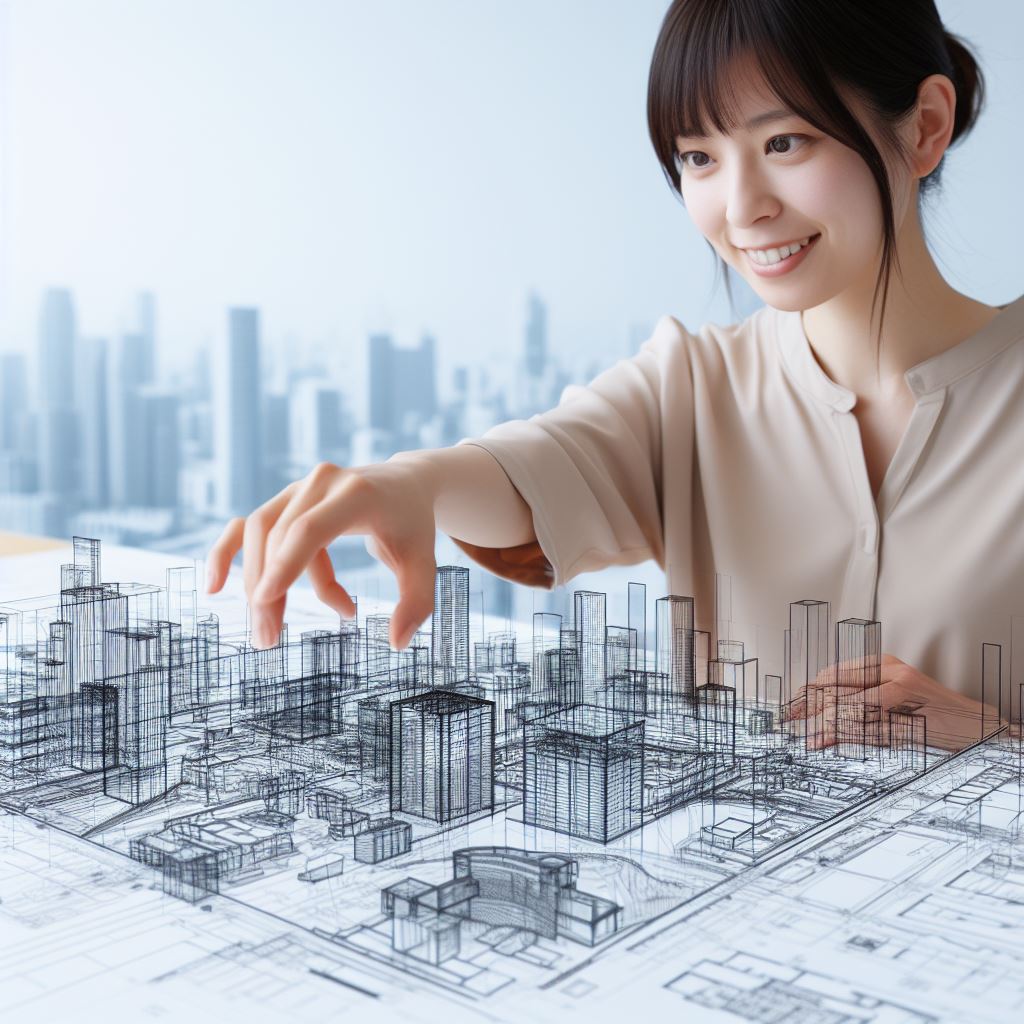Introduction
In the realm of UK architecture, technology yields transformative influence.
Advancements redefine construction, design, and creativity.
This blog navigates technology’s profound impact on architectural innovation, examining its evolutionary path.
By exploring how technology intertwines with architectural visions, we illuminate the fusion of tradition and modernity.
The purpose here is to unveil how tech innovations revolutionize architectural blueprints and urban landscapes.
Tech not only shapes aesthetics but also redefines sustainability, functionality, and structural integrity.
Dive into the synergy between technology and UK architecture, uncovering its dynamic evolution and future prospects.
Historical Overview: Evolution of UK Architecture
In order to understand the impact of technology on UK architecture, it is important to first look at the historical evolution of architectural styles and techniques in the UK.
This will provide a foundation for understanding how technology has shaped the field.
Traditional Architectural Styles and Techniques in the UK
- The UK has a rich architectural heritage, with various styles that have been prevalent throughout its history.
- One of the earliest architectural styles in the UK is the Norman style, which was introduced after the Norman Conquest in 1066.
- Norman architecture is characterized by features such as round arches, thick walls, and sturdy pillars.
- Another significant architectural style in the UK is Gothic architecture, which emerged in the 12th century.
- Gothic architecture is known for its pointed arches, ribbed vaults, and soaring spires, as seen in iconic structures like Westminster Abbey.
- During the Renaissance period, classical architectural designs from ancient Greece and Rome gained popularity in the UK.
- Neoclassical architecture, with its grand columns and symmetrical facades, became prominent in the 18th and early 19th centuries.
- The Victorian era saw a revival of Gothic architecture, known as Victorian Gothic or Neo-Gothic style.
- Victorian Gothic buildings, such as the Houses of Parliament, featured intricate detailing and ornate decorations.
- Overall, traditional architectural styles in the UK were characterized by manual construction techniques and limited technological advancements.
Major Technological Advancements in UK Architecture
- The Industrial Revolution in the 18th and 19th centuries brought significant advancements in technology that revolutionized UK architecture.
- One of the key innovations was the development of cast iron and later wrought iron for structural support.
- Iron allowed for the construction of larger and taller buildings, such as the Crystal Palace, which showcased technological progress.
- The invention of the steam engine enabled the use of machinery for construction, making the process faster and more efficient.
- An important development in the 20th century was the introduction of reinforced concrete, which offered greater structural versatility.
- Reinforced concrete allowed for the creation of innovative designs, such as the iconic Gherkin building in London.
- Advances in glass production and steel manufacturing also played a significant role in shaping UK architecture.
- Glass curtain walls, made possible by advancements in glass technology, became a defining feature of modern architectural designs.
- Modern technologies, such as computer-aided design (CAD) software, have further transformed the field of architecture in the UK.
- CAD software allows architects to create intricate designs with precision and efficiency, leading to greater innovation in building construction.
In fact, the evolution of UK architecture has been influenced by both traditional styles and technological advancements.
From Norman and Gothic styles to Neoclassical and Victorian Gothic designs, the UK has seen a range of architectural movements throughout history.
The Industrial Revolution brought significant changes with the use of cast iron, steam engines, and reinforced concrete.
Today, modern technologies such as CAD software are driving further innovation in UK architecture.
Technology has had a profound impact on the field, enabling the construction of larger, taller, and more intricate structures that define the skyline of cities like London.
Read: Famous UK Architects and Their Signature Works
Application of Technology in Design and Planning
How technology has revolutionized the design process
The use of computer-aided design (CAD) software has significantly transformed the creation of digital architectural models.
Gone are the days of hand-drawn blueprints and physical scale models.
With the advent of CAD software, architects can now easily develop and modify intricate design plans with a few clicks of a button.
CAD programs offer precision, efficiency, and flexibility that traditional methods lacked.
The ability to visualize designs in a digital platform allows architects to experiment with different materials, geometries, and lighting conditions, leading to more innovative and creative architectural solutions.
Moreover, CAD software enables seamless collaboration among multiple stakeholders, fostering effective communication and streamlining the design process.
Virtual reality (VR) and augmented reality (AR) are increasingly being leveraged in the planning stages of architectural projects.
VR allows architects and clients to experience a design in a fully immersive environment before it is built.
This technology enables users to explore the virtual space, walk through buildings, and interact with elements in real-time.
By simulating the actual environment, VR helps architects make informed decisions and identify potential design flaws or improvements early on.
On the other hand, AR supplements reality by superimposing virtual architectural elements onto the physical world.
This technology aids architects in visualizing the integration of new buildings into existing environments.
AR can overlay proposed designs onto actual sites, allowing architects and clients to envision how the project will look and function in its intended context.
Benefits and drawbacks of technology in design and planning
Technology has greatly improved accuracy and efficiency in the design and planning process.
CAD software eliminates human errors that often occur during manual drafting, resulting in precise and error-free designs.
The ability to quickly revise and update digital models saves significant time compared to traditional methods.
Moreover, virtual simulations enable architects to analyze and optimize designs, resulting in improved performance and functionality.
However, there are potential challenges and limitations that come with depending too heavily on technology in design and planning.
Overreliance on technology may lead to a lack of human touch and creativity in architectural design.
While CAD software assists in generating ideas, it is essential for architects to retain their artistic skills and design intuition.
Additionally, the cost of implementing and maintaining advanced technologies can be a barrier for smaller firms or individuals, limiting their access to these tools.
Furthermore, the reliance on virtual environments may hinder architects from fully considering the physical, social, and cultural aspects of a project.
Real-world factors, such as climate, building regulations, and community needs, may not be accurately represented in digital models.
Therefore, it is crucial for architects to balance the use of technology with a holistic understanding of the built environment.
Personalized UK Career Consulting
Receive tailored career guidance designed just for you. Get actionable steps and expert support to boost your career in 1-3 days. Take control of your career now.
Get StartedIn short, technology has revolutionized the design and planning stages of architecture in the UK.
CAD software has enabled architects to create digital architectural models with precision and efficiency.
VR and AR have facilitated immersive experiences and enhanced visualization in the planning process.
While technology offers numerous benefits in accuracy and efficiency, it is important for architects to be mindful of the potential drawbacks and limitations that can arise from an overreliance on technology.
Striking a balance between technological advancements and traditional design approaches will lead to more successful and adaptable architectural solutions.
Read: Sustainability in UK Architecture: Trends & Tips

Construction and Material Innovations
Advancements in the Construction Process
- Building Information Modeling (BIM) software has revolutionized the way construction projects are planned and executed.
- Through BIM, construction professionals can create accurate digital representations of buildings, facilitating better design and collaboration.
- This software allows architects, engineers, and contractors to work together seamlessly, improving project coordination and reducing errors.
- By using BIM, construction teams can simulate the construction process virtually, identifying potential issues and making necessary adjustments before actual construction begins.
- The integration of robotics and automation in construction has also brought significant advancements.
- Robots can perform repetitive and dangerous tasks, improving safety and efficiency on construction sites.
- Automated machinery, such as 3D printers, can fabricate building components with precision and speed.
- These technologies help accelerate the construction process, resulting in reduced costs and faster project completion.
New Materials and Techniques in Modern UK Architecture
- Sustainable materials and green building practices play a crucial role in modern UK architecture.
- Architects are increasingly using recycled and eco-friendly materials to minimize environmental impact.
- Materials such as reclaimed wood, recycled concrete, and natural insulation are becoming popular choices.
- Additionally, green building practices focus on energy efficiency, water conservation, and waste reduction.
- Smart technologies are also being incorporated to improve the functionality and sustainability of buildings.
- These technologies include energy management systems, smart lighting, and automated climate control.
- They aim to optimize energy usage, enhance occupant comfort, and reduce carbon footprint.
- Furthermore, innovative techniques like modular construction are gaining traction in the UK.
- Modular construction involves constructing building components off-site and assembling them on-site, offering greater efficiency and flexibility.
- This method reduces construction waste, minimizes disruption to local areas, and enables faster construction completion.
Technology has undoubtedly created a significant impact on the construction industry and the materials used in contemporary UK architecture.
Building Information Modeling (BIM) software has revolutionized the construction process by providing accurate digital representations of buildings.
This technology allows architects, engineers, and contractors to collaborate effectively, resulting in improved coordination and reduced errors.
By utilizing BIM software, construction teams can simulate the construction process virtually, identifying potential issues and making necessary adjustments before actual construction begins.
This virtual simulation helps minimize risks and ensures a smoother construction process.
Furthermore, the integration of robotics and automation in construction has brought about remarkable advancements.
Robots can now perform repetitive and dangerous tasks, enhancing safety and productivity on construction sites.
Automated machinery, such as 3D printers, has the capability to fabricate building components with precise measurements and at a faster pace.
This streamlined process reduces costs and speeds up project completion.
In modern UK architecture, there is a growing emphasis on sustainable materials and green building practices.
Architects are increasingly incorporating recycled and eco-friendly materials into their designs to minimize environmental impact.
Reclaimed wood, recycled concrete, and natural insulation are some of the sustainable materials being utilized.
Green building practices also focus on energy efficiency, water conservation, and waste reduction.
Buildings are now equipped with energy management systems, smart lighting, and automated climate control to optimize energy usage and enhance occupant comfort.
These smart technologies aim to reduce carbon footprint and create healthier environments.
Additionally, innovative techniques like modular construction are gaining popularity in the UK.
This construction method involves constructing building components off-site and assembling them on-site.
Modular construction offers greater efficiency and flexibility, reducing construction waste and minimizing disruption to local areas.
It also enables faster construction completion, addressing the demand for quick and cost-effective building solutions.
In essence, advancements in technology have significantly impacted the construction process and materials used in modern UK architecture.
Building Information Modeling (BIM) software and the integration of robotics and automation have revolutionized the construction industry, improving coordination and accelerating project completion.
Sustainable materials and green building practices are becoming increasingly prevalent, promoting environmentally friendly designs.
The incorporation of smart technologies enhances building functionality and energy efficiency.
With the continued development of construction and material innovations, the future of UK architecture looks promising, creating sustainable and technologically advanced buildings.
Read: Architects’ Role in UK Urban Development
You Might Also Like: Famous UK Civil Engineers & Their Legacy
Impact on Sustainability and Energy Efficiency
When it comes to sustainable architecture and energy efficiency in the United Kingdom, technology has made a profound impact.
The adoption of innovative technologies has influenced architectural practices by integrating sustainability principles into the design and construction of buildings.
Influence of Technology on Sustainable Architecture in the UK
Solar panels and other forms of renewable energy systems have become increasingly popular in UK architecture.
These technologies help to harness clean and abundant energy from the sun, reducing reliance on traditional energy sources.
As a result, buildings equipped with solar panels can generate their own electricity, significantly reducing carbon emissions and energy costs.
Additionally, technology has played a vital role in enhancing energy efficiency and reducing the carbon footprint of architectural designs.
Smart technologies, such as advanced building management systems and intelligent sensors, enable better control and optimization of energy usage within buildings.
These systems automatically adjust lighting, heating, and cooling based on occupancy and environmental conditions, resulting in substantial energy savings.
Your Dream Job Starts with a Perfect CV
Get a tailored CV and cover letter that captures your unique strengths and stands out in your industry. Let us help you make an unforgettable first impression.
Get StartedImportance of Sustainability in Modern UK Architecture
Sustainability has become a crucial consideration in modern UK architecture.
Various initiatives and certifications actively promote sustainable design practices, encouraging architects and designers to prioritize environmental responsibility.
Initiatives like BREEAM (Building Research Establishment Environmental Assessment Method) and LEED (Leadership in Energy and Environmental Design) provide guidelines and certifications that incentivize sustainable design strategies.
These frameworks reward buildings that exhibit energy efficiency, use renewable energy systems, manage resources responsibly, and prioritize environmental conservation.
Apart from the environmental benefits, sustainable architecture also brings economic advantages.
By reducing energy consumption and utilizing renewable energy sources, buildings can substantially lower operational costs in the long run.
Additionally, investments in energy-efficient technologies often increase the market value of buildings, attracting environmentally-conscious tenants and investors.
In general, technology has greatly influenced sustainable architecture and energy efficiency in the UK.
The adoption of solar panels, renewable energy systems, and smart technologies has significantly reduced carbon footprints and enhanced energy efficiency in buildings.
Moreover, sustainability has become a vital aspect of modern architecture in the UK due to various initiatives and certifications.
By combining environmentally responsible design with economic benefits, sustainable architecture is shaping the future of UK buildings.
Read: The Future of Architecture in the UK Explored
Discover More: Day in the Life of a UK Architect: Real Stories
Challenges and Future Outlook
The integration of technology in architecture brings forth immense potential, but it also poses various challenges and risks.
In this section, we will delve into the potential obstacles that need to be addressed and explore the exciting future prospects of technology in the field of UK architecture.
Potential Challenges and Risks
Concerns regarding privacy and data security
As technology becomes increasingly integrated into architectural processes, the collection and utilization of vast amounts of data raise concerns about privacy and data security.
Architects must adopt robust measures to protect sensitive information and ensure responsible data management practices.
The impact on job security for architects and construction workers
The advent of advanced technologies like artificial intelligence (AI) and machine learning has raised questions about the future of certain job roles in architecture and construction.
Architects and construction workers may face potential job displacement as automation takes over routine tasks.
It is crucial to study and address the potential impact of technology on the workforce and develop strategies to retrain and adapt job roles accordingly.
Future Prospects of Technology in UK Architecture
Emerging technologies that may further shape the field
The future of UK architecture is intertwined with cutting-edge technologies.
It is essential to explore emerging technologies such as Building Information Modelling (BIM), 3D printing, augmented reality (AR), and virtual reality (VR).
These technologies offer immense potential for improving design, visualization, and collaboration processes.
Architects need to familiarize themselves with these tools to stay ahead in the rapidly evolving industry.
The need for continued adaptation and innovation
In an era of rapid technological advancements, the ability to adapt and innovate becomes paramount.
Architects must stay updated with the latest developments to remain competitive and relevant.
Embracing technology-driven solutions requires a mindset of continuous learning and flexible problem-solving.
Proactive engagement with emerging technologies will facilitate architectural creativity and enhance the built environment.
While integrating technology in architecture brings about unprecedented possibilities, it is essential to navigate potential challenges and risks.
Privacy and data security, as well as job security concerns, require careful attention to ensure responsible adoption of technology.
Looking ahead, the future prospects of technology in UK architecture are exciting.
By embracing emerging technologies and fostering a culture of ongoing adaptation and innovation, architects can shape an increasingly sustainable, efficient, and visually stunning built environment.
Conclusion
Technology reshapes UK architecture, blending tradition with innovation.
It streamlines design processes, fostering sustainability and creativity.
The impact extends beyond aesthetics, influencing functionality and environmental considerations.
Optimize Your LinkedIn for Success
Boost your LinkedIn profile with a professional bio, keyword-rich headline, and strategic recommendations that attract recruiters. Stand out from the crowd and get noticed.
Optimize NowThrough CAD, BIM, and innovative materials, architecture embraces efficiency and visionary possibilities.
Ultimately, technology’s evolution prompts a shift in architectural paradigms.
This transformation encourages architects to navigate complexities, embracing technological advancements for progressive designs.
In the UK, technology serves as a catalyst, bridging heritage and modernity in architectural landscapes.
As we embrace these advancements, what balance will future architects strike between tradition and innovation?




